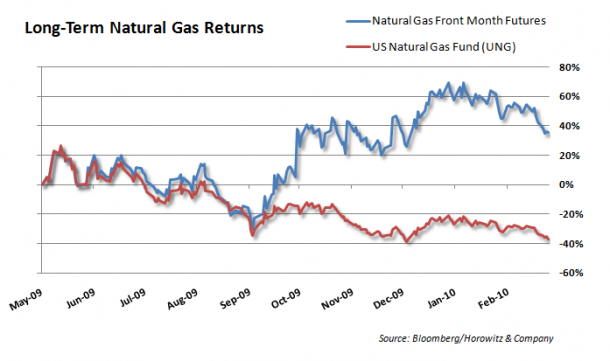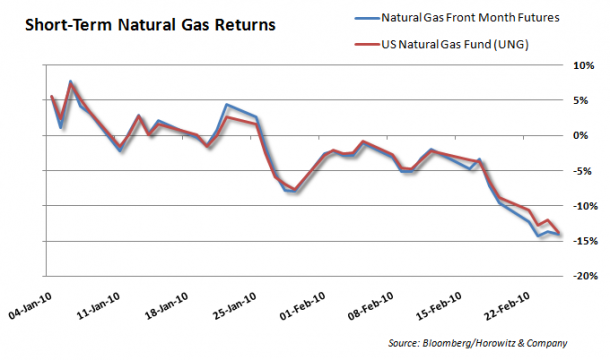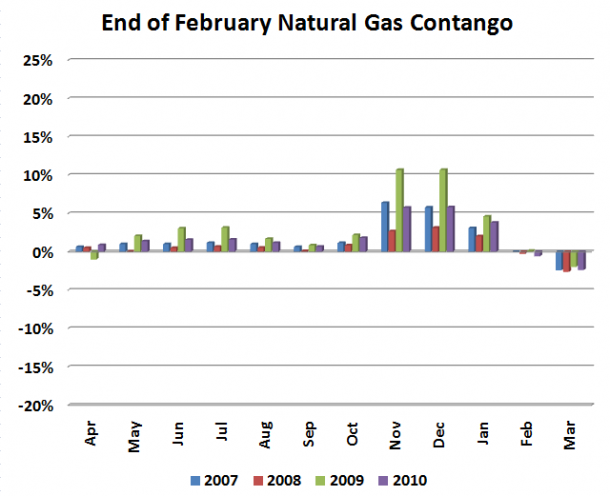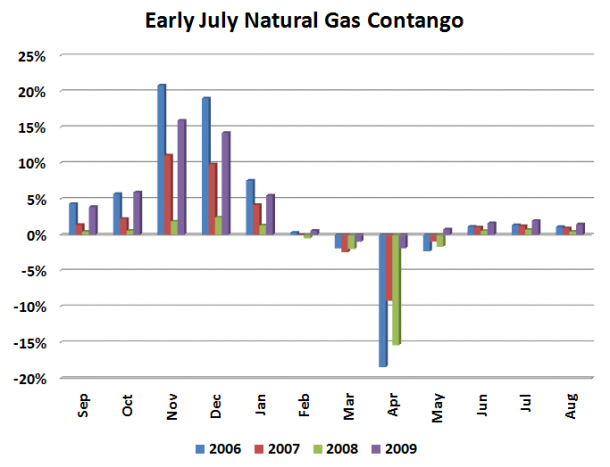We have taken a stake in Natural Gas through the United States Gas Fund (UNG) ETF. Traditionally we have shied away from this as there has been an epic departure from its performance as compared to the actual price of natural gas. But looking at the recent weather as well as the inventories has had us thinking that it may actually be an investment that we want to consider.
But how to invest when we know that UNG is such a problem in the past?
We decided to look closely at the issue that has been causing the most problems for investors in this fund: Contango. What we found was more than interesting, it was almost routine.
There is a far greater chance that contango will reduce your returns when investing in (UNG) in the summer months as opposed to the winter. Below we have illustrated the price differential of the the spread between the front-month and forward month for the natural gas futures contract.
The chart below shows that there is minimal contango (generally less than 3%) for Natural gas futures purchased in February. This is consistent going back to 2006.
On the other hand, there is SEVERE Contango (as well as times of Normal Backwardation) when buying in the summer months such as July. This helps us to understand that there should be a better correlation to the actual price moves of natural gas futures to the ETF United States natural gas Fund (UNG) in other times. The negative effect of Contango has consistently provided a good deal of pain to investor who have bought-and-held the position.
From Briefing.com (with highlights)
Working gas in storage was 1,853 Bcf as of Friday, February 19, 2010, according to EIA estimates.
This represents a net decline of 172 Bcf from the previous week. Stocks were 56 Bcf less than last year at this time and 13 Bcf above the 5-year average of 1,840 Bcf.
In the East Region, stocks were 23 Bcf below the 5-year average following net withdrawals of 95 Bcf. Stocks in the Producing Region were 20 Bcf below the 5-year average of 627 Bcf after a net withdrawal of 66 Bcf.
Stocks in the West Region were 56 Bcf above the 5-year average after a net drawdown of 11 Bcf. At 1,853 Bcf, total working gas is within the 5-year historical range.
From Bloomberg:
U.S. natural gas inventories fell last week, according to the U.S. Department of Energy.
Inventories fell 8.5 percent, or 172 billion cubic feet, to 1.853 trillion in the week ended Feb. 19. A Bloomberg survey expected inventories to fall 169 billion cubic feet to 1.856 trillion cubic feet.
The following charts detail inventories for natural gas immediately available for withdrawal in billions of cubic feet:

___
Disclosure: Horowitz & Company clients may hold positions of securities mentioned as of the date published.
last week, according to the U.S. Department of Energy.
Inventories fell 8.5 percent, or 172 billion cubic feet, to
1.853 trillion in the week ended Feb. 19. A Bloomberg survey
expected inventories to fall 169 billion cubic feet to 1.856
trillion cubic feet.
The following table details inventories for natural gas
immediately available for withdrawal in billions of cubic feetWorking gas in storage was 1,853 Bcf as of Friday, February 19, 2010, according to EIA estimates. This represents a net decline of 172 Bcf from the previous week. Stocks were 56 Bcf less than last year at this time and 13 Bcf above the 5-year average of 1,840 Bcf. In the East Region, stocks were 23 Bcf below the 5-year average following net withdrawals of 95 Bcf. Stocks in the Producing Region were 20 Bcf below the 5-year average of 627 Bcf after a net withdrawal of 66 Bcf. Stocks in the West Region were 56 Bcf above the 5-year average after a net drawdown of 11 Bcf. At 1,853 Bcf, total working gas is within the 5-year historical range.:




















